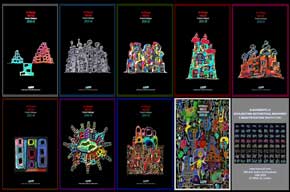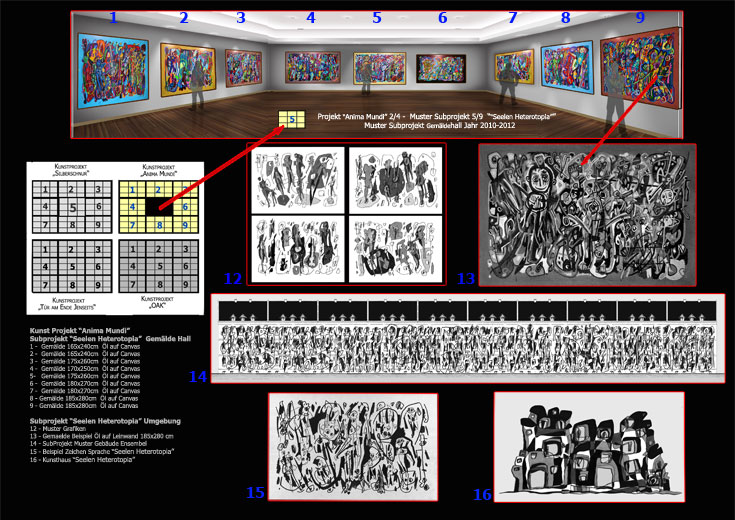The Interior Civilization
an Abstract artistic painting and Design multiconcept
© NiK-KiA 1960-2060
The "Interior Civilization" is the Main Idea, Philosophy and fundament for NiK-KiA Art Activities. The “The Interior Civilization” as a General Idea of NiK-KiA past, actuel and future Art's concepts and projects for the first time determined in the year 2000 with followings Goals:
- The General path for Implementation of the Main Idea (Interior Civilization) is abstract artistic illustration, graphic drawings and oil paintings;
- The new Civilization will construct in a creative, abstract and fantasy approach, with structural concepts and related with each concept multi number of art projects and subprojects;
- General idea named ''The Interior Civilization'' , in its content will be inspirited, designed and implement in base of Human interior life, spirituality, virtuality, Moral and Psychology;
- The "Interior Civilization" will content a complex designed abstract figurative multi Languages organism (Hieroglyphics Language) ;
- Motivated from goals of main Idea the Architecture, Urban and Cityscape images will directed, recovered and transform to a new designed face;
- "The New Civilization" architecture concept has not only the elements of artistic renovation of old houses but also designing and funding new series of house, quarters, urban and cityscape objects;
- The concept must formulate a purposal social, economic, and culture analyze in use of spiritual nature of people in region;
- The Geographic implementation activity of "new Civilization Ideas" spreads in different projects Worldwide.
Image sample of one Project 36 art projects,
art project 5/9 "Sellen Heteropia" from concept 1/4 "the souls and spirits globe" in following images:
Later at year 2008 the Idea of “The Interior Civilization” become more concrete element and aspect as follow:
- “The Silberschnur” © NiK-KiA year 1996-2008 (links to text and cataloge 2010-15);
- “The Spirits and Soul afterlife Globe” © NiK-KiA year 2008-12 (links to concept’s text and cataloge 2015-20);
- “Anima Mundi” © NiK-KiA is plans for year 2014-18; (links to text and cataloge 2020-25);
- “The Transitional Beings” © NiK-KiA is plans for year 2020-25. (links to text and cataloge 2025-30).
- Every group of graphics, paintings, project and concepted is organized as a serial in a matrix form (2x2, 3x3, 4x4, 5x5 matrix);
- The Idea at last step consists of four concept (2x2), every concept nine project (3x3), every project nine or sixteen paintings (3x3, 4x4), every graphic serial four, nine, sixteein or twenthy-five unit (2x2, 3x3, 4x4, or 5x5);
- It means in the last station the Idea in its implementation path will contain 729 large paintings or more (upto 300x400 cm large) and over as 100,000 graphics and sketches is in need;
- The same matrix process is will implement for architctur, urban and cityscape processes;
The Concept Elements define as following:
- Civilization is often used as a synonym for the broader term "culture" in both popular and academic circles. Every human being participates in a culture, defined as "the arts, customs, habits... beliefs, values, behavior and material habits that constitute a people's way of life". However, in its most widely used definition, civilization is a descriptive term for a relatively complex agricultural and urban culture. Civilizations can be distinguished from other cultures by their high level of social complexity and organization, and by their diverse economic and cultural activities.
Civilization can also describe the Culture of a complex society, not just the society itself. Every society, civilization or not, has a specific set of ideas and customs, and a certain set of items and arts, that make it unique. Civilizations have even more intricate cultures, including literature, professional art, architecture, organized religion, and complex customs associated with the elite. Civilization is such in nature that it seeks to spread, to have more, to expand, and the means by which to do this.
- However, the word Culture is most commonly used in three basic senses:
- Excellence of taste in the Fine art and Humanities, also known as High culture
- An integrated pattern of human knowledge, belief, and behavior that depends upon the capacity for symbolic thought and social learning
- The set of shared attitudes, values, goals, and practices that characterizes an institution, organization or group
- Conceptual art is Art in which the concept(s) or idea(s) involved in the work take precedence over traditional Aesthetics and material concerns. Many of the works, sometimes called >installations, of the artist Sol LeWitt may be constructed by anyone simply by following a set of written instructions.
- Architecture is the art and science of designing buildings and other physical structures.
- Urban design concerns the arrangement, appearance and functionality of towns and cities, and in particular the shaping and uses of urban public space. It has traditionally been regarded as a disciplinary subset of urban planning, Landscape architecture, or architectureand in more recent times has been linked to emergent disciplines such as landscape urbanism. However, with its increasing prominence in the activities of these disciplines, it is better conceptualised as a design practice that operates at the intersection of all three, and requires a good understanding of a range of others besides, such as urban economics, Political economy and social theory.
- Urban art is a style of art that relates to cities and city life often done by artists who live in or have a passion for city life. The term urban means "from the city". Sometimes Urban art is called "street art".
- An urban area is an area with an increased Population density of human-created structures in comparison to the areas surrounding it. Urban areas may be cities, towns or conurbations, but the term is not commonly extended to rural settlements such as villages and hamlets. Unlike an urban area, a metropolitan area includes not only the urban area, but also satellite cities plus intervening rural land that is socio-economically connected to the urban core city, typically by employment ties through commuting, with the urban core city being the primary labor market. In fact, urbanized areas agglomerate and grow as the core population/economic activity center within a larger metropolitan area or envelope.
- A cityscape is the urban equivalent of a landscape. Townscape is roughly synonymous with cityscape, though it of course implies the same difference in urban size and density (and even modernity) implicit in the difference between the words city and town. Inurban design the terms refer to the configuration of built forms and interstitial space. In the visual arts a cityscape (urban landscape) in artistic representation, such as a painting, drawing, print or photograph, of the physical aspects of a city or urban area.
- Egyptian hieroglyphs itself pronounced was a formal writing system> used by the ancient Egyptians that contained a combination of logographic and alphabetic elements. Egyptians used cursive hieroglyphs for religious literature on papyrus and wood. Less formal variations of the script, called hieratic and demotic, are technically not hieroglyphs.
(C) NiK-KiA 2000
(C) Artist Designer nikkia 2000
Baky - Dortmund - Almaty - Charleston (WV) - London - Los Angeles - Moscow - Paris - Ruhr - Tehran
01.07.2009
allrights reserved 1960-2060 Nikrouz Kianouri
![]()
nikrouz kianowww.kianouri.com (C) Kianouri Academy (C) AA100000 (C) Kianouri Nikrouz (C) www.nikrouz.com copyright 1960-2060u

